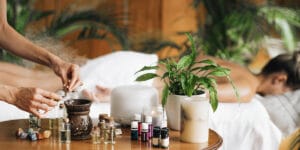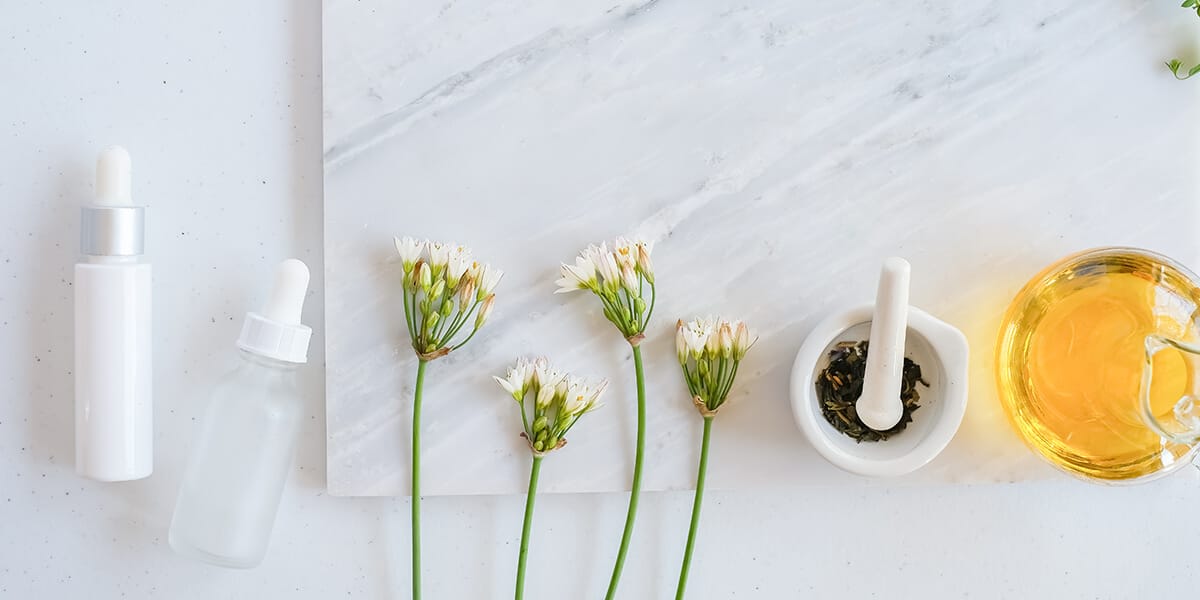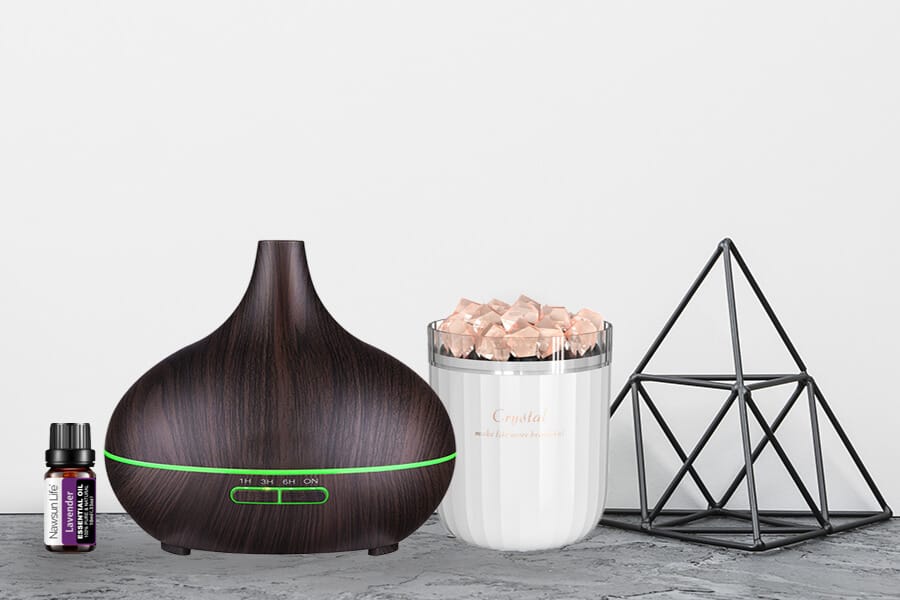Essential oils are natural gifts that can help us in resolving many of our daily concerns. Essential oils have a wide range of applications. Some people believe that essential oils are only used to make things smell nice or enhance a massage’s enjoyment. The truth is that essential oils have a plethora of applications in everyday life, many of which you may not have considered.
Modern science has proven that essential oils have a variety of benefits for our health and well-being. Essential oils can be applied topically or inhaled to relieve many conditions such as headaches, insomnia, stress, depression.
With a basic understanding of safety precautions and application methods, it is easy to start using essential oils. In this article, you will learn the basics of how to use these wonderful natural gifts.
First Things First, What Are Essential Oils?

Essential oils are compounds extracted from numerous plant components, consisting of flowers, leaves, bark, seeds, roots, branches, and more. Essential oils are the essence of a plant, a present from the planet, and prepared for you to bring the power of nature right into your home.
Related: What Are Essential Oils? – Essential Oils 101
How to Use Essential Oils
1. Aromatic Use of Essential Oils
What does the word aromatic mean? Aromatic means that it has a distinct, potent, or pleasant aroma. When you use an essential oil aromatically, you enjoy the oil’s benefits and smell through the air.
Aromatic use is one of the three primary methods for applying essential oils. As previously stated, aromatic service allows us to reap the benefits of essential oils through the air. That is one method of application.

The aromatic use of essential oils is the most popular application method because it is simple and allows you to enjoy the aroma of an essential oil almost immediately.
Now that we’ve defined aromatic usage let’s look at what happens when we use essential oils aromatically. The benefits of aromatic use are not limited to just enjoying the wonderful fragrance. Aromatic essential oils can also be used as a mood-enhancing or stress-reducing agent, for healing properties such as relief from headaches, insomnia, anxiety, and more.
The sense of smell is a highly effective tool for eliciting physiological solid, psychological, and emotional responses. Essential oils are rapidly absorbed by smell receptors, which directly connect to the limbic system, the area of the brain responsible for memory and emotion storage. Certain essential oils have an uplifting or energizing effect, while others have a calming effect.
Diffusing essential oils is one of the simplest ways to use essential oils aromatically. Diffusing oils in the morning is an excellent way to start your day off right. Then, throughout the day, alternate between stimulating oils for work or study and uplifting oils to boost energy.
Inhalation is another great way to enjoy aromatically using essential oils, especially if you don’t want the oil on your skin or hair or don’t want others nearby bothered by its smell. You can inhale directly from the bottle, put a few drops in each hand and cover with one palm while breathing deeply, use an inhaler that administers just the right amount of time per dose, or even make homemade vapor rubs.
A popular use of inhalations is adding lavender oil and peppermint oil together for their balancing qualities- perfect after long days at work when you feel overstimulated.
You may use an essential oil diffuser if you wish, but aromatically diffusing essential oils does not require any special devices.
5 Ways to Use Essential Oils Aromatically:
- The easiest way: Simply placing a few drops of essential oil in the palm of your hand, cupping it around your nose, and breathing deeply.
- Diffuser method: Mix essential oils and water in an essential oil diffuser and turn on the diffuser. A diffuser is a device that disperses tiny oil particles around the room so you can breathe them in.
- Spray method: Mix essential oils in a spray bottle with water and mist over furniture, carpet, or linens.
- Dry evaporation: Add drops of essential oil to a cotton ball and place it in the gym bag, car air vent, office table.
- Steam inhalation: Put a few drops of essential oil in a bowl of hot water. Put your head over the bowl, a towel over your head, and breathe in the steam.
2. Topical Use of Essential Oils
The topical application of essential oils is one of the quickest and easiest ways to experience the health benefits of essential oils. When used properly, essential oils can be highly beneficial to the skin, energizing to the body, helpful for massage, and useful in various ways in daily life.

Topical application is unique in that it enables the user to concentrate the desired effect on specific areas of the body. When applied topically, essential oils can help improve the appearance and tone of the skin. Additionally, because essential oils penetrate the skin easily and provide specific benefits, topical application is an excellent way to experience the benefits of essential oils.
We should note that while topical use of essential oils is often considered safe, some people may have allergic reactions to the oil or it could irritate sensitive skin. Essential oils can also interfere with certain medical conditions and medications, so individuals who wish to use them topically should consult their doctor before starting any treatment plan. Topical applications can be used in various ways depending on the desired benefits. We may use tea tree oil for acne, lavender oil for pain relief, peppermint or eucalyptus oil for antihistamine.
Check with the manufacturer before applying any essential oil to your skin to ensure safe use. Furthermore, never use essential oils (even topically safe ones) in your ears, eyes, or on broken or injured skin.
Beneficial Areas You Can Apply Essential Oils:
- Temples, forehead, or back of the neck
- Behind and outside of ears
- Shoulders, chest, over heart, and abdomen
- Arms and wrists
- Legs, heels, bottom of the big toe, bottom of feet
Related: The Johns Hopkins Medicine – Do Essential Oils Really Work?
3. Internal Use of Essential Oils
Did you know that you can benefit from essential oils by ingesting them? When essential oils are ingested, they enter the bloodstream directly through the intestinal system and are transported throughout the body. Essential oils are easily transported to all of our body’s organs.
Internal use can provide benefits that the other two application methods cannot offer in some cases. Though some are skeptical of the efficacy of internal use, research backs up the potential benefits of ingesting essential oils.
Essential oils can be used internally to support digestive function, maintain healthy immune function, encourage better cell function, provide internal cleansing benefits to the body, and more.
Four Effective Methods of Internal Application:
- Mixed with food or beverages. (Please note that essential oil ingestion is not recommended during pregnancy)
- Dropped 1 or 2 drops of essential oils onto the tongue and held for at least 30 seconds before swallowing.
- Applied to a capsule, taken as directed by your healthcare practitioner or pharmacist.
4. Essential Oils for Personal Care
Did you know that essential oils can be used in cosmetics? Essential oils are commonly used in personal care products and cosmetics, like perfumes, toothpaste, mouthwashes, lotions, moisturizers, cleansers, lotions, and ointments. Essential oils have a powerful smell that can be transferred into the product, but it also has potent benefits.
Essential oils aren’t just limited to cosmetics – they’re great for your hair too. Thanks to their natural cleansing properties, you’ll find them frequently seen as part of shampoos and conditioners.
The lavender essential oil can be mixed into your daily moisturizer to help soothe skin irritations and soothe the skin. Lavender can also be used after shaving to help relieve the skin and prevent sensitivity. Lavender can even be added to the conditioner to soothe your strands while also providing a pleasant aroma. Lavender, Tea Tree, Jasmine, Melissa, Helichrysum, and Sandalwood are just a few of the oils used to soothe and promote healthy skin.
Aside from skincare, several essential oils have impressive hair benefits. You can add essential oils like Ylang Ylang, Rosemary, Geranium, or Tea Tree to your haircare routine to help give your locks a little extra life.
5. Essential Oils for Cleaning
To keep your space looking, feeling, and smelling clean, you can use essential oils with surface cleansing benefits. There are many reasons essential oils can be a better option than chemical cleaners, and they will make your home smell nice and remain healthy as you clean.
It is excellent to use essential oils for cleaning because they are entirely safe, natural, and do not have the unpleasant side effects that some sanitizers do. They’ll enhance the potency of your cleaners, naturally, scent your house, and you’ll come into contact with the therapeutic benefits of their natural products daily. You can create non-toxic cleaners for your entire home using just a few easy-to-find ingredients.
Use a cup of warm water, a cup of white vinegar, and 20–25 drops of essential oil to make an all-purpose cleaning spray. You can add a few drops of essential oils to the rinse cycle to create a fragrant load, or you can use dryer sheets to give your clothes a fresh, clean scent when they are ready to be laundered.
Different Types of Essential Oils for Cleaning:
- Because of its gentle characteristics and calming fragrance, essential oils derived from lavender and tea tree complement homemade laundry soap and dryer balls. Additionally, it is an excellent choice for hand soaps and cleansers, as it enhances antibacterial characteristics without being too harsh on the skin.
- Another incredibly versatile and popular essential oil is peppermint essential oil. Its menthol content contains antibacterial and antifungal properties, which is why it is popular in all-purpose cleaning mixtures. It is also thought to be effective at repelling ants and mice. It can be used as pest sprays around door frames and other points of entry, or a few drops can be placed on a cotton ball and placed in areas where pests are present to prevent them.
- Due to the antibacterial, antiviral, and antifungal properties of tea tree and cinnamon leaf essential oils, they are ideal for use in germ-fighting and antimicrobial formulations. Cinnamon, on the other hand, is an effective deodorizer.
- Lemon essential oil possesses significant antibacterial, antimicrobial, and degreasing capabilities, making it an indispensable component of homemade green cleaners. Due to its high sanitizing capacity, it is beneficial when applied in all-purpose sprays and surface cleansers. It is particularly effective as a degreaser in dish soap and other grease-cutting formulations.
Get free guides & sources to help grow your aromatherapy business.
No charge. Unsubscribe anytime.





